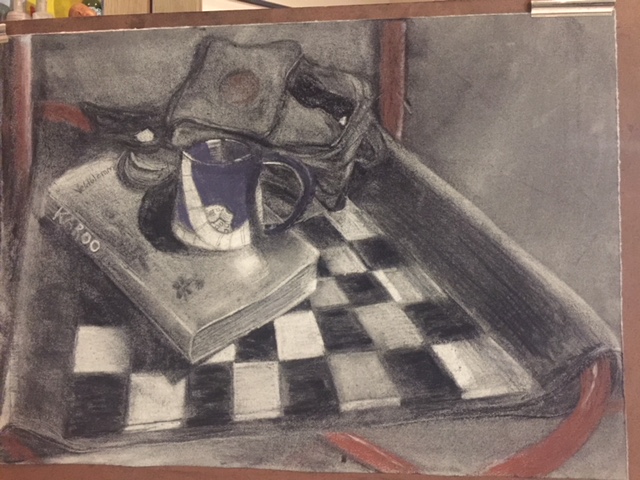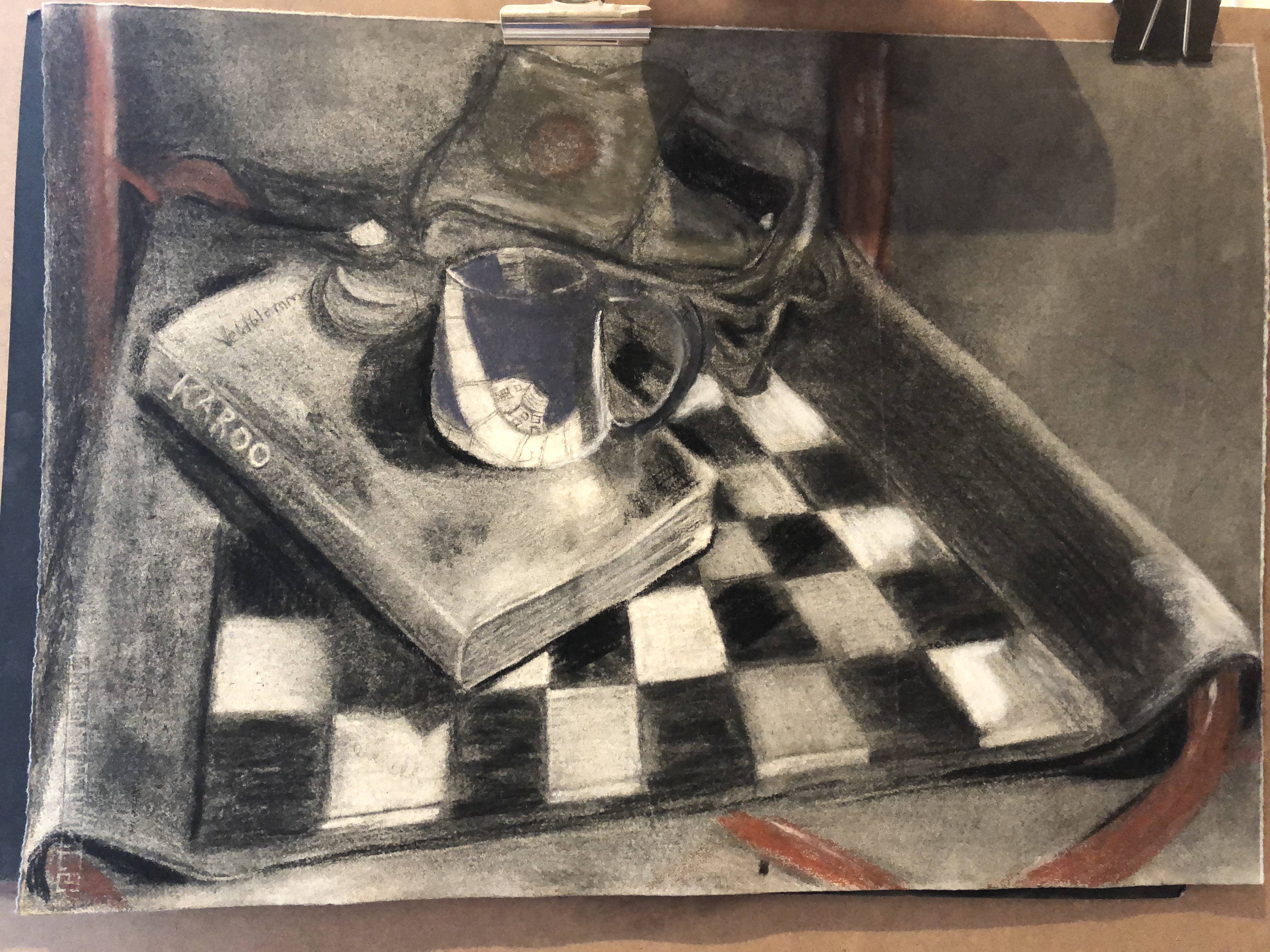8 May 2018
Draw a Still Life with objects that trigger a response for me.
- focus on interesting shapes and angles, and
- ensure good reflected light in order to
- create a range of tonality in the drawing,
- also ensure to use mark making.
- Work on a sheet of A3 or A2 paper and
- use a range of drawing tools.
I decide the following objects: my binocular in its bag, a Camelthorn tree pod, a book on the flowering plants of the Karoo area and a coffee mug, all set on a Chess board. We are soon leaving South Africa for Dubais, with the plan to return to South Africa in 3 years. I love nature and have spent many days on safari and or camping in our natural bush/veld areas with my Zeiss binoculars always close by. I love our birds, indigenous trees, wildflowers, as well as butterflies and the wild animals. I read and learn as much possible before we visit an area. The pod is part of a collection of ‘species’ I have collected over time. The book represents all I have learnt about the natural habitats I have had the privilege to visit over many years. My cousin is a potter and this delicate and favourite mug is part of a range she made – line drawings of a village under a blue sky is ‘etched’ onto the mug in its wet stage. My husband made this chessboard with Tambotie wood – this is an indigenous and poisonous tree with a very dark core and almost white cambium. ( the wood is only poisonous when used as fire wood). Chess playing has been a favourite for the family whilst sitting out an afternoon heat in the bush. I will reminisce about camping under a Camelthorn tree and all these objects will stay close to my heart, wherever I find myself. At least I will have regular coffees out of this mug and be able to visit my memories, whilst daydreaming or being homesick. “Man is nothing but the soil of his small country; nothing but the shape of his native landscape” (Saul Tchernichovsky)
Starting – seems there are squares everywhere. On my photo (monochrome) I see potential for tonal values, shades and different angles. At this stage I started to contemplate to put the items on my camping chair, and decide to add my favourite camping chair to the composition and change the lighting to get more shadows and reflected light.
I need to work on shadows and light and other medium – conte pencil, will add to the exercise, as I have never used this before. I love the oily feel it has when applying it to the paper. I need to add texture to the canvass seat of the chair as well as the canvass bag of the binoculars. I have used a charcoal dipped in linseed oil for 10 min – dark leather on canvas bag.

Reflections on assignment one
From the start of the course I realised that lines in drawing are an explorative topic, apart form being important in any composition and good drawing. It made me look at work of other artists. I was particularly astonished to see, almost for the first time, the lack of lines an artist like Marlene Dumas use as she puts down paint and almost sculpt with tone and form. I felt comfortable holding a charcoal stick in my hand for a drawing, but most of the other materials were much harder and more technical skill and practice is needed. I loved the focus on awareness during the exercises and finding my own fluidity with lines and voice to express this was a real challenge. I am stretched to work on a wide range of materials and find this experience to show out my doubts about composition and drawing skills. I see the importance of spending daily time drawing and reflecting on my observational and technical skills and have now added at least 30 minutes drawing time to my daily schedule.
I have not spent much time doing Still Lives in the past and found the topic challenging. I realised that one should set aside a few hours just for planning and compositional ideas. I almost felt constraint by the composition after I first made a choice and then changed it. I think this shows lack of understanding planning of a drawing. I know my weakness in this situation is that I am impulsive about what and when I set out to draw/paint. Spending time on planning and a few small sketches should be routine. I think the same applies for the fact that I added the blue charcoal and the conte stick. The drawing process would have been less complicated had I lifted the chair to my own eye level.
At this stage I think I should have done more exercises during Part 0ne. Almost that I moved though it too quick. I need guidance in this regard as well as on planning for the next assignment. I also need guidance as to the way I use the learning log/blog. Should it be more formal and differently laid out?
I enjoyed the project and are excited to develop my skill further. I see myself as a full time student and are able to spend at least 5 -6 hours daily (5 days a week) on this subject for the next 3 months at least.
Feedback from Tutor 15/04/2018
Assignment
I feel encouraged my my first feedback from my tutor. He finds my blog well-designed and easy to navigate. My tutor also enjoys my writing style – ” you are articulate and personal in good balance” – I feel this comes natural for me as I am trying to be genuine and true to my own direction.
With regards to the exercises:
No bubble drawings – I saw it as more of a look and see exercise to get me going. I should make my images bigger. My tutor challenged me with exercise four, groups of objects, to do a more analytical linear drawings – pencil/pen and to think points/lines/planes, technical drawing. I will attempt this and add this to my blog.
The suggestion is to use lightning more in the drawing – more focus on light and shadow created by 3D form. I understand I should develop this play with light in the way I set up objects and scenes, use very minimal directional light in a dark space, to push the tonal contrast further. I would like to explore this more – develop this project further as suggested by my tutor, the line drawing of the red book, as well as my thoughts on Redon and Seurat – with regards to a study of objects where my interest in object’s stories can continue to meet the visual, mark-making, textural, linear and tonal qualities of my chosen forms. I am indeed very interested in printmaking – the “red book” drawing exercise would be a great opportunity in this regard. I like the idea of making it a ‘body of work’ – Hockney’s prints are very inspirational, yes. As my tutor mention, in that approach I will push various threads further and can choose later which I feel is most interesting/successful.
- It is clear that if I take note of mark making, textural, linear and tonal qualities of forms I will be able to create good visual material. –
- experimenting more.. ” you can afford to allow play and experimentation.
- Develop on my successes I achieved with the line drawings and colour
- develop several preparatory drawings as part of assignment pieces too
- develop ‘your play with light in how you set up your objects and scenes’
- get the images bigger on the blog – very important as during the whole course this will be the only way my tutor can view my work. He suggest some close ups, where detail is important.
- bringing in the experiences of museum visits
With regards to the assignment of Part One:
Encouraged by …’enjoyed seeing your various experiments come together..” I need to work more on the lightning …”to create a more dramatic contrast‘ and are encouraged to look at the Chiaroscuro works to learn to push the light and dark contrasts further. I think my tutor is spot on with his remarks that I was too consumed with the tonal variations of the chess board and mug, that I missed the opportunity to focus more on the light and shadows which were created by 3 D form.
